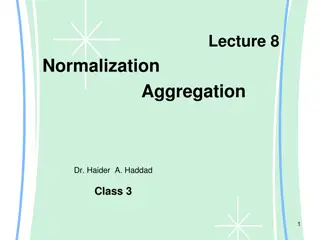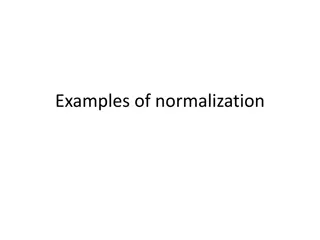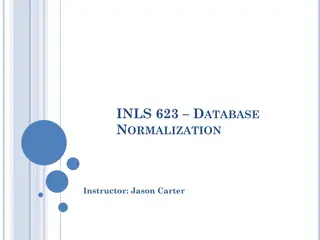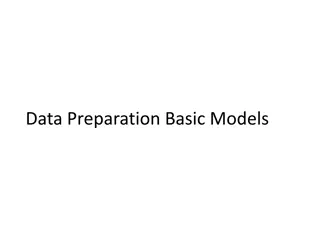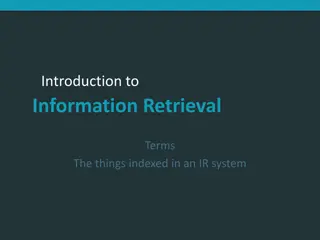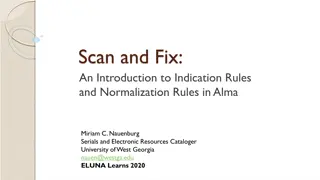Understanding Database Normalization Techniques
Database normalization is a crucial technique for organizing data efficiently to eliminate redundancy and anomalies. It involves decomposing tables to ensure data integrity and minimize inconsistencies. Common issues without normalization include excessive memory usage and data manipulation problems. The process follows specific normalization rules to achieve optimal database structure.
Uploaded on Sep 10, 2024 | 4 Views
Download Presentation

Please find below an Image/Link to download the presentation.
The content on the website is provided AS IS for your information and personal use only. It may not be sold, licensed, or shared on other websites without obtaining consent from the author. Download presentation by click this link. If you encounter any issues during the download, it is possible that the publisher has removed the file from their server.
E N D
Presentation Transcript
Normalization of Database Presented by Ms. DahibhateAngha Department of CS & IT Deogiri College, Aurangabad Maharashtra, 431 005 1
Database Management System Normalization of Database
Database Normalization is a technique of organizing the data in the database. Normalization is a systematic approach of decomposing tables to eliminate data redundancy(repetition) and undesirable characteristics like Insertion, Update and Deletion Anomalies. It is a multi-step process that puts data into tabular form, removing duplicated data from the relation tables. Normalization is used for mainly two purposes, Eliminating redundant(useless) data. Ensuring data dependencies make sense i.e data is logically stored.
Problems Without Normalization If a table is not properly normalized and have data redundancy then it will not only eat up extra memory space but will also make it difficult to handle and update the database, without facing data loss. Insertion, Updation and Deletion Anomalies are very frequent if database is not normalized. To understand these anomalies let us take an example of a Student table. Insertion Anomaly: Suppose for a new admission, until and unless a student opts for a branch, data of the student cannot be inserted, or else we will have to set the branch information as NULL. Also, if we have to insert data of 100 students of same branch, then the branch information will be repeated for all those 100 students. These scenarios are nothing but Insertion anomalies.
Updation Anomaly: What if Mr. X leaves the college? or is no longer the HOD of computer science department? In that case all the student records will have to be updated, and if by mistake we miss any record, it will lead to data inconsistency. This is Updation anomaly. Deletion Anomaly: In our Student table, two different informations are kept together, Student information and Branch information. Hence, at the end of the academic year, if student records are deleted, we will also lose the branch information. This is Deletion anomaly.
Rollno Name Branch HOD office_tel 401 Akon CSE Mr. X 53337 402 Bkon CSE Mr. X 53337 403 Ckon CSE Mr. X 53337 404 Dkon CSE Mr. X 53337
Normalization Rule: Normalization rules are divided into the following normal forms: 1. First Normal Form 2. Second Normal Form 3. Third Normal Form 4. BCNF 5. Fourth Normal Form
1. First Normal Form (1NF): The First normal form (1NF) sets basic rules for an organized database Define the data items required, because they become the columns in a table. You must define the data items. This means looking at the data to be stored, organizing the data into columns, defining what type of data each column contains and then finally putting the related columns into their own table. Place the related data items in a table. Ensure that there are no repeating groups of data. Ensure that there is a primary key.
2. Second Normal Form (2NF) : For a table to be in the Second Normal Form, It should be in the First Normal form. And, it should not have Partial Dependency. Example: Student_id Name Reg_no Branch Address 11 Riya DC123 CSE KERALA 12 Nakul DC134 IT GUJRAT 13 Nakul DC678 CSE BIHAR
Partial dependency: where an attribute in a table depends on only a part of the primary key and not on the whole key. Let's create another table Score, to store the marks obtained by students in the respective subjects. We will also be saving name of the teacher who teaches that subject along with marks. score_id student_id subject_id marks teacher 1 10 1 70 Java Teacher 2 10 2 75 C++ Teacher 3 11 1 80 Java Teacher
Now if you look at the Score table, we have a column names teachers which is only dependent on the subject, for Java it's Java Teacher and for C++ it's C++ Teacher & so on. Now as we just discussed that the primary key for this table is a composition of two columns which is student_id and subjest_id but the teacher's name only depends on subject, hence the subject_id and has nothing to do with student_id. This is Partial Dependency, where an attribute in a table depends on only a part of the primary key and not on the whole key. Remove partial dependency: The simplest solution is to remove columns teachers from Score table and add it to the Subject table. And our Score table is now in the second normal form, with no partial dependency
score_id student_id subject_id marks 1 10 1 70 2 11 2 75 3 12 1 80 subject_id subject_name teacher 1 Java Java Teacher 2 C++ C++ Teacher 3 Php Php Teacher
3. Third Normal Form (3NF) A table is said to be in the Third Normal Form when, It is in the Second Normal form. And, it doesn't have Transitive Dependency. Transitive dependency: When a non-prime attribute depends on other non-prime attributes rather than depending upon the prime attributes or primary key. Example: In the Score table, we need to store some more information, which is the exam name and total marks, so let's add 2 more columns to the Score table. With exam_name and Total marks added to our Score table, it saves more data now. Primary key for our Score table is a composite key, which means it's made up of two attributes or columns student_id + subject_id.
Our new column exam_name name depends on both student and subject. For example, a mechanical engineering student will have Workshop exam but a computer science student won't. And for some subjects you have Practical exams and for some you don't. So we can say that exam name is depend upon both student_id and subject_id. Well, the column total_marks depend upon exam_name as with exam type the total score changes. For example, practicals are of less marks while theory exams are of more marks. But exam_name is just another column in the score table. It is not a primary key or even a part of the primary key, and total_marks depend on it. This is Transitive Dependency. When a non-prime attribute depends on other non-prime attributes rather than depending upon the prime attributes or primary key.
Score_id Student_id Subject_id Exam_name Total marks Marks 1 2 score_id student_id subject_id marks exam_id exam_id exam_name total_marks 1 Workshop 200 2 Mains 70 3 Practicals 30
4. Boyce and Codd Normal Form is a higher version of the Third Normal form. This form deals with certain type of anomaly that is not handled by 3NF. A 3NF table which does not have multiple overlapping candidate keys is said to be in BCNF. For a table to be in BCNF, following conditions must be satisfied: R must be in 3rd Normal Form and, for each functional dependency ( X Y ), X should be a super Key. In simple words, it means, that for a dependency A B, A cannot be a non-prime attribute, if B is a prime attribute. Example: College Table
Stu_ID SUBJECT PROFESSOR 101 C++ ABC 101 JAVA PQR 102 C++ ABC 103 JAVA KLM In the table above: One student can enrol for multiple subjects. For example, student with student_id 101, has opted for subjects - Java & C++ For each subject, a professor is assigned to the student. And, there can be multiple professors teaching one subject like we have for Java.
The above table satisfies all of 3 Normal Form. But this table is not in BCNF. In the above table stu_id and subject form primary key, which mean subject column is prime attribute. But, there is one more dependency, professor subject. And subject is prime attribute, professor is a non prime attribute, which is not allowed by BCNF. To make this relation(table) satisfy BCNF, we will decompose this table into two tables, student table and professor table.
Fourth Normal Form (4NF) A table is said to be in the Fourth Normal Form when, It is in the Boyce-Codd Normal Form. And, it doesn't have Multi-Valued Dependency. Multi-Valued Dependency:- A table is said to have multi-valued dependency, if the following conditions are true: 1. For a dependency A B, if for a single value of A, multiple value of B exists, then the table may have multi-valued dependency. 2. Also, a table should have at-least 3 columns for it to have a multi-valued dependency. 3. And, for a relation R(A,B,C) , ), if there is a multi-valued dependency between, A and B, then B and C should be independent of each other.
Example: below we have a college enrolment table with coloum s_id , course, hobby. And, in the table above, there is no relationship between the columns course and hobby They are independent of each other. So there is multi-value dependency, which leads to un-necessary repetition of data and other anomalies as well.
To make the above relation satisfy the 4th normal form, we can decompose the table into 2 tables. Now this relation satisfies the fourth normal form. A table can also have functional dependency along with multi-valued dependency. In that case, the functionally dependent columns are moved in a separate table and the multi-valued dependent columns are moved to separate tables.





